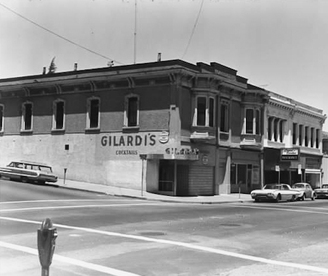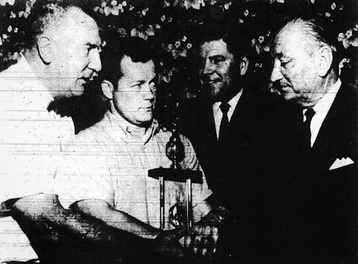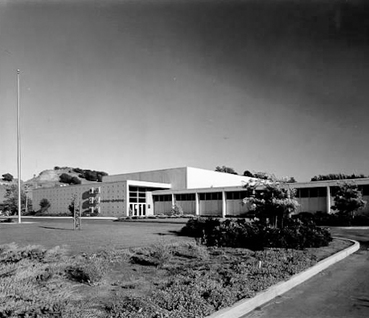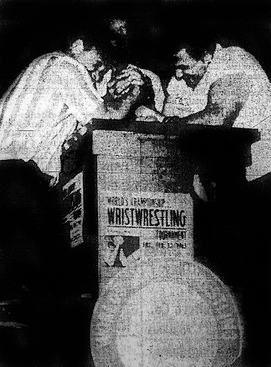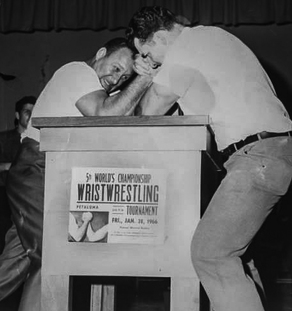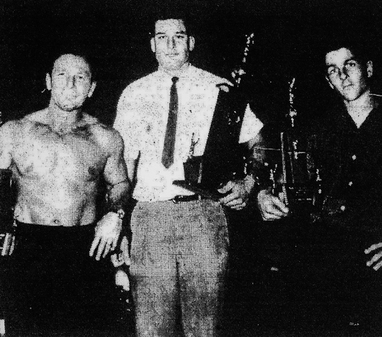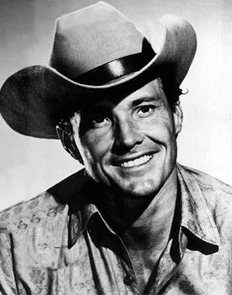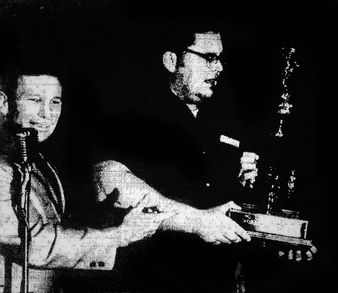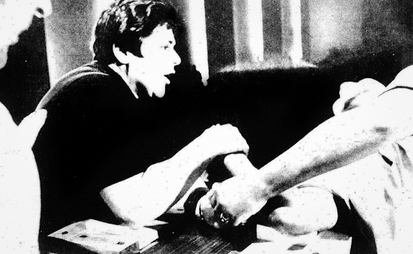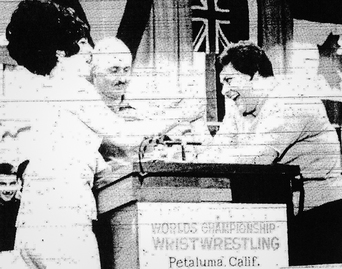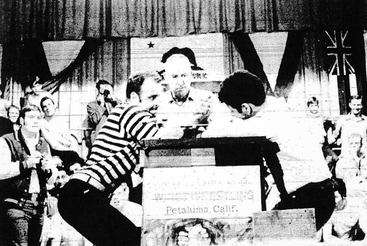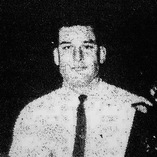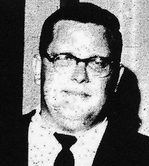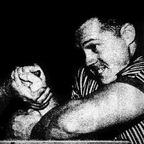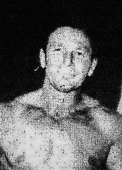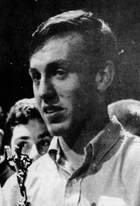The History of the World’s Wristwrestling Championship - Part Two
1962 to 1969 - The World is Invited
In six short years, what had begun with a friendly challenge match at Gilardi’s Corner had evolved into the sport of wristwrestling, with established rules and a purpose-built table. By 1961, the annual Petaluma contest was known as the California Wristwrestling Championship, and people were traveling significant distances to attend the Friday night event. The growing interest was putting a strain on the tournament locale, and more and more spectators had to be turned away each year. It was time to move to a bigger venue.
Following the 1961 contest, Bill Soberanes did some research and determined that a world wristwrestling championship did not yet exist. What better way was there to promote a contest than to call it a world championship? Bill, along with promoter Mike Gilardi and wristwrestling official Jack Homel, decided to form World’s Wristwrestling Championship, Inc. Mike would serve as President, Jack as Vice-President, and Bill as Secretary-Treasurer. The 1962 contest would be the first World’s Wristwrestling Championship, and it would be held in Hermann Sons Hall: the second largest auditorium in Petaluma.
The 1962 March of Dimes World Championship Wristwrestling Tournament was scheduled for the evening of Friday, February 2nd. Bill, a columnist for the Petaluma Argus-Courier, was well positioned to promote the event locally, and significant efforts were made to promote it well beyond northern California as sports writers, radio, and television plugged the event in the week leading up to the tournament.
On the night of the contest, approximately 1,000 people paid the $1 admission fee to be able to watch the wristwrestling and to see the many area celebrities from the sports and entertainment fields (the event was billed as having the greatest array of sports celebrities in the history of Petaluma on hand). The event was officially opened by Everett Mantzen, the mayor of Petaluma. Thirty men were about to take part in a contest that would crown the inaugural World’s Wristwrestling Champion.
On the night of the contest, approximately 1,000 people paid the $1 admission fee to be able to watch the wristwrestling and to see the many area celebrities from the sports and entertainment fields (the event was billed as having the greatest array of sports celebrities in the history of Petaluma on hand). The event was officially opened by Everett Mantzen, the mayor of Petaluma. Thirty men were about to take part in a contest that would crown the inaugural World’s Wristwrestling Champion.
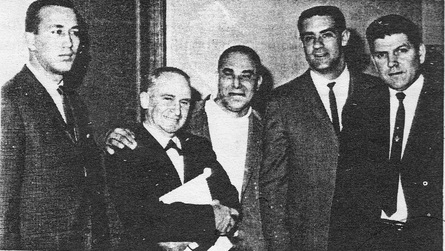
Group pic from the 1962 tournament. Tom Flores (first from left) and Tom Louderback (second from right) were football players with the Oakland Raiders. They brought their mutual friend, Joe Valencia (center), and bet that he would win the tournament. Joe eventually lost to Duane Benedix. Also pictured are Augie Lepori (second from left), master of ceremonies for several of the early tournaments, and Bill Soberanes (far right).
Like the contests that preceded it, the inaugural World Championship featured only a single, open, men’s right-hand division. Competitors’ elbows were set in a two-inch space. If the elbow left this space, a default would be given and the match would be restarted. Two defaults equalled a loss.
Every match, a competitor’s dream of becoming the champion was crushed in the single elimination contest. By the end of the night, only two men remained—the same two men who faced off in the final of the preceding year’s California Championship. In 1961, Duane Benedix, a 6’3” 265-lb electrician from Livermore, California, managed to go undefeated in his first ever wristwrestling contest. His final match that night was against Earl Hagerman, the California Champion of the three previous years (1958-1960).
Earl, a much smaller man than Duane at 5’8” and 215 lbs, was determined to take back the championship crown. When he gripped up with Benedix for the final match of the evening, he made sure to be ready for Jack Homel’s start command. Hagerman was faster off the go, allowing him to bend his opponent’s wrist back and get his arm off center. Duane fought hard, but was not able to recover, and after 17 and half seconds Earl Hagerman became the first World’s Wristwrestling Champion.
Despite the fact that all competitors in the inaugural World Championship were from California, the event was deemed a great success. Several hundred dollars were raised for the March of Dimes and the crowd clearly enjoyed the show.
Every match, a competitor’s dream of becoming the champion was crushed in the single elimination contest. By the end of the night, only two men remained—the same two men who faced off in the final of the preceding year’s California Championship. In 1961, Duane Benedix, a 6’3” 265-lb electrician from Livermore, California, managed to go undefeated in his first ever wristwrestling contest. His final match that night was against Earl Hagerman, the California Champion of the three previous years (1958-1960).
Earl, a much smaller man than Duane at 5’8” and 215 lbs, was determined to take back the championship crown. When he gripped up with Benedix for the final match of the evening, he made sure to be ready for Jack Homel’s start command. Hagerman was faster off the go, allowing him to bend his opponent’s wrist back and get his arm off center. Duane fought hard, but was not able to recover, and after 17 and half seconds Earl Hagerman became the first World’s Wristwrestling Champion.
Despite the fact that all competitors in the inaugural World Championship were from California, the event was deemed a great success. Several hundred dollars were raised for the March of Dimes and the crowd clearly enjoyed the show.
Though Hermann Sons Hall’s capacity was four times that of Gilardi’s Corner, it still was not big enough to accommodate the amount of people who wanted to attend the World Championship. So, in 1963 the event was moved to the Petaluma Veterans Memorial Auditorium: the biggest hall in town.
A few other changes were made for the 1963 contest. An under 200-lb division was added to give smaller men a better chance to be competitive. The winner of the unlimited would be recognized as the World Champion, while the winner of the under 200-lb division would be given a California State title. Also, for the first time, two men would share officiating duties. While Jack Homel had been the sole referee since the contests began, this time he would be helped by March of Dimes campaign director Nick Kobseff.
The World Championship’s association with the March of Dimes changed slightly in 1963. “March of Dimes” was dropped from the contest name, and while much of the proceeds of the event would go to the charity, 40% of the gate receipts would be divided among the top five finishers in the unlimited division (with the champion getting the biggest share). This marked the first time that competitors would be financially rewarded for their efforts.
On the night of the contest, 31 men competed: 16 in the under 200-lb division, and 15 in the unlimited division. Some were disappointed that the number of entries in the unlimited division was half that of the previous year’s contest. However, it wasn’t too surprising due to the addition of the second class. Another factor that was considered as having played a part in the lack of competitors was the fact that a female competitor had announced that she would be competing with the men. She was unbeaten and believed she could do well in the contest. This caused some of the male competitors to withdraw, because they saw being matched up against a woman to be a no-win situation for them. Ultimately, the female competitor did not show up to the event.
Though the number of entries was lighter than expected, many of the matches rang true to the WWC’s motto of “Raw Strength and Courage” (“strength” alluding to the strength required to compete in wristwrestling and “courage” referencing the courage required to get up on stage and compete in front of a large crowd). The crowd of 1,300 on hand certainly seemed to appreciate the show.
In the end, Petaluma’s own Harvey Balestrini was crowned California Champion for winning the under 200-lb division. Along with this title, he was presented with a large trophy recognizing his achievement.
The World Championship’s association with the March of Dimes changed slightly in 1963. “March of Dimes” was dropped from the contest name, and while much of the proceeds of the event would go to the charity, 40% of the gate receipts would be divided among the top five finishers in the unlimited division (with the champion getting the biggest share). This marked the first time that competitors would be financially rewarded for their efforts.
On the night of the contest, 31 men competed: 16 in the under 200-lb division, and 15 in the unlimited division. Some were disappointed that the number of entries in the unlimited division was half that of the previous year’s contest. However, it wasn’t too surprising due to the addition of the second class. Another factor that was considered as having played a part in the lack of competitors was the fact that a female competitor had announced that she would be competing with the men. She was unbeaten and believed she could do well in the contest. This caused some of the male competitors to withdraw, because they saw being matched up against a woman to be a no-win situation for them. Ultimately, the female competitor did not show up to the event.
Though the number of entries was lighter than expected, many of the matches rang true to the WWC’s motto of “Raw Strength and Courage” (“strength” alluding to the strength required to compete in wristwrestling and “courage” referencing the courage required to get up on stage and compete in front of a large crowd). The crowd of 1,300 on hand certainly seemed to appreciate the show.
In the end, Petaluma’s own Harvey Balestrini was crowned California Champion for winning the under 200-lb division. Along with this title, he was presented with a large trophy recognizing his achievement.
In the unlimited division, for the third year in a row the final match paired Earl “The Mighty Atom” Hagerman and Duane “Tiny” Benedix. Not surprisingly, Tiny was not happy about his loss to Earl in the 1962 tournament, and he was determined to win back the world title in 1963. In preparation, he built himself a table on which to practice and trained intensely for several months. This time, when the official gave the start command he was ready, and he proceeded to pin Earl in just four seconds!
The 1964 contest was promoted more than any tournament that preceded it to make it bigger than ever. Many boxers, football players, and local celebrities were invited to attend. Radio DJs, television shows, and newspapers from hundreds of miles away plugged the event. And Bill Soberanes proclaimed Petaluma the “Wristwrestling Capital of the World” (a proclamation that would be made official by the city in 1969).
Two more divisions were added in 1964: a lightweight division (up to 175 lbs), and an open women’s division. Like the under 200-lb division added the previous year, the 175-lb division would be contested for a California Champion title, while the women’s division champion would be recognized as the Women’s World Champion.
The result of the increased promotion and the addition of two divisions? A contest with more than twice the number of entries as ever before!
A handful of men chose to compete in multiple classes. One of these men was Jimmy Payne, the 1950 International Federation of Body Builders (IFBB) Mr. America champion. Jimmy, whose muscles were not just for show, entered and won the 175-lb division, beating 1963 California Champion Harvey Balestrini in the finals.
Earl Hagerman also competed in two divisions. After losing in the finals of the unlimited division in 1963, he decided to drop a bit of weight to try his luck in the under 200-lb class. He managed to win this division, beating newcomer Larry Cory in the process. However Larry, yet another person who decided to compete in two classes, got a bit of revenge by beating Earl in the unlimited division, only to lose in the finals against 280-lb Joe Schuler, an Oakdale meat truck driver. Though expected to attend, Tiny Benedix did not make the drive from Livermore to defend his title, which was a disappointment to the fans who wanted to see if someone could beat him.
In the women’s division, San Francisco nightclub performer Barbara Sappington emerged victorious from a field of four competitors. In doing so, she became the first Women’s World’s World Wristwrestling Champion.
Though labeled as a World Championship since 1962, 1964 was actually the first year that the contest managed to attract competition from outside of California, with a team from Oregon and a lone competitor from Pennsylvania making the trip.
Two more divisions were added in 1964: a lightweight division (up to 175 lbs), and an open women’s division. Like the under 200-lb division added the previous year, the 175-lb division would be contested for a California Champion title, while the women’s division champion would be recognized as the Women’s World Champion.
The result of the increased promotion and the addition of two divisions? A contest with more than twice the number of entries as ever before!
A handful of men chose to compete in multiple classes. One of these men was Jimmy Payne, the 1950 International Federation of Body Builders (IFBB) Mr. America champion. Jimmy, whose muscles were not just for show, entered and won the 175-lb division, beating 1963 California Champion Harvey Balestrini in the finals.
Earl Hagerman also competed in two divisions. After losing in the finals of the unlimited division in 1963, he decided to drop a bit of weight to try his luck in the under 200-lb class. He managed to win this division, beating newcomer Larry Cory in the process. However Larry, yet another person who decided to compete in two classes, got a bit of revenge by beating Earl in the unlimited division, only to lose in the finals against 280-lb Joe Schuler, an Oakdale meat truck driver. Though expected to attend, Tiny Benedix did not make the drive from Livermore to defend his title, which was a disappointment to the fans who wanted to see if someone could beat him.
In the women’s division, San Francisco nightclub performer Barbara Sappington emerged victorious from a field of four competitors. In doing so, she became the first Women’s World’s World Wristwrestling Champion.
Though labeled as a World Championship since 1962, 1964 was actually the first year that the contest managed to attract competition from outside of California, with a team from Oregon and a lone competitor from Pennsylvania making the trip.
By 1965, regional wristwrestling tournaments were starting to be held in a few areas around the country, with the winners being invited to the World Championship in Petaluma. This played a part in boosting state representation to five, up two from the previous year.
Jack Homel built a new, sturdier table for the 1965 event to withstand the force generated by largest and strongest of competitors. It featured cups in which the elbows of the competing arms had to remain.
Jimmy Payne returned for the 1965 contest. Having enjoyed himself so much at the 1965 event, he volunteered to take part in promotional activities for the 1965 contest, and even performed a balancing act at the contest intermission, in addition to competing in two classes!
Bert Elliott, Californian body builder, weightlifter, and strongman, also attended the event to both compete and to cover the contest for Muscle Builder magazine. The subsequent article helped build nationwide awareness of the championship.
Jack Homel built a new, sturdier table for the 1965 event to withstand the force generated by largest and strongest of competitors. It featured cups in which the elbows of the competing arms had to remain.
Jimmy Payne returned for the 1965 contest. Having enjoyed himself so much at the 1965 event, he volunteered to take part in promotional activities for the 1965 contest, and even performed a balancing act at the contest intermission, in addition to competing in two classes!
Bert Elliott, Californian body builder, weightlifter, and strongman, also attended the event to both compete and to cover the contest for Muscle Builder magazine. The subsequent article helped build nationwide awareness of the championship.
Barbara Sappington returned to defend her Women’s World Champion title. She only needed to beat one other competitor to successfully do so. The few other women that had pre-registered did not show up the night of the contest.
For the first time in the event’s history, an out-of-state competitor was crowned champion. Harry Stayner Jr., a 22-year old from Eugene, Oregon, won the lightweight division among a large field of competitors, which included Jimmy Payne. Harry happened to be the reigning Oregon State and Northwest Champion.
Already the most decorated wristwrestler, Earl Hagerman managed to win yet another championship title in the middleweight division. This brought his total number of titles to five.
Big Joe Schuler returned to defend his World Champion crown, only to be bested by the smaller Arnie Klein in the semi-finals. Arnie was a former halfback at the University of Northern California and a California gymnastics champion from 1944 to 1947. In this, his first ever wristwrestling contest, Arnie managed to become World Champion! The runner-up in this division was Larry Cory, making it two years of heartbreak for the young man.
For the first time in the event’s history, an out-of-state competitor was crowned champion. Harry Stayner Jr., a 22-year old from Eugene, Oregon, won the lightweight division among a large field of competitors, which included Jimmy Payne. Harry happened to be the reigning Oregon State and Northwest Champion.
Already the most decorated wristwrestler, Earl Hagerman managed to win yet another championship title in the middleweight division. This brought his total number of titles to five.
Big Joe Schuler returned to defend his World Champion crown, only to be bested by the smaller Arnie Klein in the semi-finals. Arnie was a former halfback at the University of Northern California and a California gymnastics champion from 1944 to 1947. In this, his first ever wristwrestling contest, Arnie managed to become World Champion! The runner-up in this division was Larry Cory, making it two years of heartbreak for the young man.
In 1966, World Champion titles were up for grabs in the lightweight and middleweight divisions. The winners of these classes would finally be recognized in the same manner as the winner of the unlimited division. Though “World Champion” titles would be bestowed to all four champions, the winner of the heavyweight class would still get a bit extra. This year the special prize was a Honda Trail 55, a trail bike motorcycle.
Bert Elliott attended the contest again, both to compete and likely to conduct some research. He would go on to help establish a new organization: the International Federation of Wrist Wrestling (later known as the International Federation of Arm Wrestlers (IFAW)). Working with Mac Batchelor, and in association with the IFBB, the IFAW would hold wristwrestling/armwrestling tournaments in conjunction with major bodybuilding competitions. Though still six months away from the IFAW’s initial contest, Bert probably wanted to learn as much as possible about the organized sport.
Perhaps disappointed by the light turnout in the women’s division 1965, Barbara Sappington did not return to defend her title. In fact, only one woman showed up, and she wasn’t even there to compete! Susan Dior, a go-go girl from Penngrove, California, was in attendance to present the awards to the winners at the end of the evening. As no women had registered for the tournament, she was invited to the stage to take part in a mock match with Bill Soberanes. She pinned him, and was subsequently given the Women’s World Champion crown by default.
Jimmy Payne’s involvement in the contest went up a notch by becoming co-master of ceremonies for the 1966 championship. He was constantly running around: in addition to this new role, he also did a weightlifting and balancing act during the intermission and competed in two classes! Not only that, but he was also able to win the inaugural lightweight division world title, which he added to the California title he won two years previously.
Richard Kennedy, a mercury miner from Sebastopol, California, emerged victorious in the middleweight division. He had trained for the event by pulling an inner tube attached to a table: a technique that would later be adopted by many successful pullers.
The unlimited division was once again won by a newcomer. This time it was Mike Rowe, a 23-year old nightclub bouncer and former discuss champion at the University of Southern California. He beat defending champion Arnie Klein in the finals in a match where Arnie got the initial jump. When interviewed following the match, Arnie said that he had never faced someone as strong as Mike.
Bert Elliott attended the contest again, both to compete and likely to conduct some research. He would go on to help establish a new organization: the International Federation of Wrist Wrestling (later known as the International Federation of Arm Wrestlers (IFAW)). Working with Mac Batchelor, and in association with the IFBB, the IFAW would hold wristwrestling/armwrestling tournaments in conjunction with major bodybuilding competitions. Though still six months away from the IFAW’s initial contest, Bert probably wanted to learn as much as possible about the organized sport.
Perhaps disappointed by the light turnout in the women’s division 1965, Barbara Sappington did not return to defend her title. In fact, only one woman showed up, and she wasn’t even there to compete! Susan Dior, a go-go girl from Penngrove, California, was in attendance to present the awards to the winners at the end of the evening. As no women had registered for the tournament, she was invited to the stage to take part in a mock match with Bill Soberanes. She pinned him, and was subsequently given the Women’s World Champion crown by default.
Jimmy Payne’s involvement in the contest went up a notch by becoming co-master of ceremonies for the 1966 championship. He was constantly running around: in addition to this new role, he also did a weightlifting and balancing act during the intermission and competed in two classes! Not only that, but he was also able to win the inaugural lightweight division world title, which he added to the California title he won two years previously.
Richard Kennedy, a mercury miner from Sebastopol, California, emerged victorious in the middleweight division. He had trained for the event by pulling an inner tube attached to a table: a technique that would later be adopted by many successful pullers.
The unlimited division was once again won by a newcomer. This time it was Mike Rowe, a 23-year old nightclub bouncer and former discuss champion at the University of Southern California. He beat defending champion Arnie Klein in the finals in a match where Arnie got the initial jump. When interviewed following the match, Arnie said that he had never faced someone as strong as Mike.
The evening was capped off by the inaugural induction ceremony for the newly formed Wristwrestling Hall of Fame. The first inductee was none other than Earl Hagerman, who had won 5 California titles in addition to the inaugural World Champion title. He was awarded a bronze plaque, and during his acceptance speech announced his retirement from the sport.
Like all World’s Wristwrestling Championships that preceded it, the 1967 contest was a grand affair. The evening kicked off with a performance by an 18-piece band. Several sports celebrities and local entertainers were on hand to mingle with the audience. And it even managed to assemble the largest number of wristwrestlers to date.
In the days leading up to the event, there was a bit of extra anticipation, as word came from Bert Elliott that television and film star Bill Smith (who at the time was starring in “Laredo”, a popular television show) was planning to attend the contest. Bill had some wristwrestling credentials, as he was the IFAW World Champion of the Motion Picture and TV Industry. It would have been interesting to see how he would have fared in the 200-lb division at the World’s Wristwrestling Championship, but unfortunately he did not show up.
In the days leading up to the event, there was a bit of extra anticipation, as word came from Bert Elliott that television and film star Bill Smith (who at the time was starring in “Laredo”, a popular television show) was planning to attend the contest. Bill had some wristwrestling credentials, as he was the IFAW World Champion of the Motion Picture and TV Industry. It would have been interesting to see how he would have fared in the 200-lb division at the World’s Wristwrestling Championship, but unfortunately he did not show up.
The lightweight division featured the greatest number of competitors: 39 in all. 19-year old Petaluman and first-time competitor Joe Tresch, managed to finish at the top of the class, to the crowd’s delight. Local boys always received the largest cheers.
In the middleweight division, defending champion Richard Kennedy was defeated in the quarter-finals by Jim Pollock, a 30-year old insurance broker. Jim would go on to win the division, after pinning 16-year old Petaluman Jim Dolcini in a 34-second match in the finals. The young Dolcini entered the contest to avoid paying admission (as had always been tradition, all competing wristwrestlers were admitted free of charge). That decision almost led him to win a world championship title in his first attempt! His little brother, Mike Dolcini, pulled the lightweight division to avoid paying admission as well. He too made it deep into the tournament before losing in the quarter-finals. Quite an achievement for a 14-year old 8th grader!
Unfortunately, Mike Rowe, the 1966 unlimited division champion, did not attend to defend his title. He was in the Marines and was believed to be serving overseas. This opened the door for 6’5 330-lb Larry Finley, who won the contest with relative ease. Though crowned as the new world champion, Larry couldn’t help but be a bit disappointed. He really wanted a chance to beat Mike, as he had lost to him in the semi-finals of the 1966 contest.
In the middleweight division, defending champion Richard Kennedy was defeated in the quarter-finals by Jim Pollock, a 30-year old insurance broker. Jim would go on to win the division, after pinning 16-year old Petaluman Jim Dolcini in a 34-second match in the finals. The young Dolcini entered the contest to avoid paying admission (as had always been tradition, all competing wristwrestlers were admitted free of charge). That decision almost led him to win a world championship title in his first attempt! His little brother, Mike Dolcini, pulled the lightweight division to avoid paying admission as well. He too made it deep into the tournament before losing in the quarter-finals. Quite an achievement for a 14-year old 8th grader!
Unfortunately, Mike Rowe, the 1966 unlimited division champion, did not attend to defend his title. He was in the Marines and was believed to be serving overseas. This opened the door for 6’5 330-lb Larry Finley, who won the contest with relative ease. Though crowned as the new world champion, Larry couldn’t help but be a bit disappointed. He really wanted a chance to beat Mike, as he had lost to him in the semi-finals of the 1966 contest.
A new world champion was crowned in the women’s division. Susan Dior, the single entrant in the 1966 contest, was not present for the 1967 championship. However, four new contestants were ready to compete. Mickie Novas, a softball player from Oakland, California, wins the division in dominant fashion.
At the conclusion of the event, the second inductee into the Wristwrestling Hall of Fame was introduced. It was none other than Jimmy Payne, the co-master of ceremonies of the contest, for his success and service to wristwrestling over the years.
While the level of media attention given to the World’s Wristwrestling Championship grew steadily since the inaugural event in 1962, the 1968 contest saw a real spike in worldwide awareness and media interest. The reason? A beagle named Snoopy. Charles Schulz, famed creator of the Peanuts comic strip, lived in Sebastopol, a Northern California town just 15 miles away from Petaluma. He had read about the contest in a local paper a couple of years earlier, and came up with a storyline which sees Snoopy train for and eventually go to Petaluma to try to win the World Championship. The original plan was for the 11-strip story to appear in newspapers during the week and a half following the 1967 tournament, but a decision was made to delay publication to the days leading up to the 1968 contest. In doing so, millions of people learned of the tournament's existence. (In the late '60s, Peanuts was the most popular comic strip in America. Worldwide, the strip ran in well over 1,000 newspapers in dozens of countries.)
At the conclusion of the event, the second inductee into the Wristwrestling Hall of Fame was introduced. It was none other than Jimmy Payne, the co-master of ceremonies of the contest, for his success and service to wristwrestling over the years.
While the level of media attention given to the World’s Wristwrestling Championship grew steadily since the inaugural event in 1962, the 1968 contest saw a real spike in worldwide awareness and media interest. The reason? A beagle named Snoopy. Charles Schulz, famed creator of the Peanuts comic strip, lived in Sebastopol, a Northern California town just 15 miles away from Petaluma. He had read about the contest in a local paper a couple of years earlier, and came up with a storyline which sees Snoopy train for and eventually go to Petaluma to try to win the World Championship. The original plan was for the 11-strip story to appear in newspapers during the week and a half following the 1967 tournament, but a decision was made to delay publication to the days leading up to the 1968 contest. In doing so, millions of people learned of the tournament's existence. (In the late '60s, Peanuts was the most popular comic strip in America. Worldwide, the strip ran in well over 1,000 newspapers in dozens of countries.)
The exposure generated by the Peanuts strips resulted in hundreds of inquiries flooding into Petaluma. Most letters received were from readers who asked if the contest really existed, and how they could take part in it. National media also wanted to learn all about the championship. Newsweek and Sports Illustrated expressed interest, and the Wall Street Journal ran a front-page article on the day of the contest. Plus, CBS announced it would be covering the event for a segment on the Saturday Evening News.
On the day of the big event, the final Petaluma-themed Peanuts strip was published. Snoopy had been training for the Championship, but in the end was disqualified because he has no thumbs!
Jimmy Payne and Bert Elliott were among those who were able to compete. However, they both lost their initial matches, which allowed them to concentrate on their respective roles during the contest: Jimmy was the master of ceremonies, while Bert helped officiate. Earl Hagerman also helped with officiating duties, but he did not compete.
Mickie Novas attended the contest and won the women’s world title for the second year in a row. She finished atop a field of six competitors, which represented the greatest number of entries to date for the women’s division.
On the day of the big event, the final Petaluma-themed Peanuts strip was published. Snoopy had been training for the Championship, but in the end was disqualified because he has no thumbs!
Jimmy Payne and Bert Elliott were among those who were able to compete. However, they both lost their initial matches, which allowed them to concentrate on their respective roles during the contest: Jimmy was the master of ceremonies, while Bert helped officiate. Earl Hagerman also helped with officiating duties, but he did not compete.
Mickie Novas attended the contest and won the women’s world title for the second year in a row. She finished atop a field of six competitors, which represented the greatest number of entries to date for the women’s division.
A couple of local teenagers also shined on this night. John Brayton, a senior in high school, won the 32-man lightweight class and Jim Dolcini, a high school junior, took the 200-pound title by beating 1967 champ Jim Pollock in the finals (a reversal of the 1967 middleweight finals).
Perhaps because of the increased publicity, Tiny Benedix returned to Petaluma to compete in the unlimited division for the first time in five years. Everyone was eager to see if he was still as good as he used to be. He easily won his first couple of matches before facing 1967 World Champion Larry Finley in the quarter-finals. Fans were on the edge of their seats when the match was about to start. The start command was given, and a minor struggle ensued. However it wasn’t long before Tiny pinned Larry’s arm. Tiny continued on to win the event, becoming the first person in history to win the unlimited division World Championship title twice. In recognition of his win, Mr. Benedix later received a commendation from the city of Livermore for bringing honor to the city.
Perhaps because of the increased publicity, Tiny Benedix returned to Petaluma to compete in the unlimited division for the first time in five years. Everyone was eager to see if he was still as good as he used to be. He easily won his first couple of matches before facing 1967 World Champion Larry Finley in the quarter-finals. Fans were on the edge of their seats when the match was about to start. The start command was given, and a minor struggle ensued. However it wasn’t long before Tiny pinned Larry’s arm. Tiny continued on to win the event, becoming the first person in history to win the unlimited division World Championship title twice. In recognition of his win, Mr. Benedix later received a commendation from the city of Livermore for bringing honor to the city.
The 1968 contest was the biggest the World’s Wristwrestling Championship to date, but the organizers were confident that it could be even bigger. They knew that if the event could get onto national television, there would be huge potential for growth. Dave Devoto, a Petaluma insurance broker, got involved to try to make this happen for the 1969 tournament.
Dave’s first exposure to wristwrestling dates back to around 1956 when he attended the Petaluma Wristwrestling Contest at Gilardi’s Corner. His dad had told him about the event and thought he might like to give it a shot. When Dave arrived and found out the contest only had an open right hand division, he decided to watch instead (he was left-handed and considerably smaller than some of the competitors). It was at this contest that Dave first met Bill Soberanes. The two became closer friends when Dave moved to Petaluma from Santa Rosa in 1961 and his insurance office was next door to the Argus-Courier. At that time, Dave was one of the people who suggested that Bill move the contest to a bigger venue and label it as a World Championship.
By the end of the ‘60s, convinced of the sports appeal, Dave decided he would see what he could do to get the contest televised. He managed to get the phone number of one of the nation’s top sports broadcasters from Jack Homel, who was able to obtain it due to the connections he had made through his many years as a Major League Baseball trainer. Dave spoke to the contact on a few occasions about the contest and sent him background information. The broadcaster in turn managed to get ABC to look into the World’s Wristwrestling Championship, and they ultimately decided to film the contest for later airing on the Wide World of Sports – a popular national television show which was known for covering many non-mainstream sports. ABC agreed to pay $500 to film the 1969 contest.
Dave’s first exposure to wristwrestling dates back to around 1956 when he attended the Petaluma Wristwrestling Contest at Gilardi’s Corner. His dad had told him about the event and thought he might like to give it a shot. When Dave arrived and found out the contest only had an open right hand division, he decided to watch instead (he was left-handed and considerably smaller than some of the competitors). It was at this contest that Dave first met Bill Soberanes. The two became closer friends when Dave moved to Petaluma from Santa Rosa in 1961 and his insurance office was next door to the Argus-Courier. At that time, Dave was one of the people who suggested that Bill move the contest to a bigger venue and label it as a World Championship.
By the end of the ‘60s, convinced of the sports appeal, Dave decided he would see what he could do to get the contest televised. He managed to get the phone number of one of the nation’s top sports broadcasters from Jack Homel, who was able to obtain it due to the connections he had made through his many years as a Major League Baseball trainer. Dave spoke to the contact on a few occasions about the contest and sent him background information. The broadcaster in turn managed to get ABC to look into the World’s Wristwrestling Championship, and they ultimately decided to film the contest for later airing on the Wide World of Sports – a popular national television show which was known for covering many non-mainstream sports. ABC agreed to pay $500 to film the 1969 contest.
To ensure the event ran smoothly for its first appearance on national television, the contest organizers ensured all the top people were involved. As always, Jack Homel would serve as head referee, while Bert Elliott and Earl Hagerman would share in the officiating duties. Jimmy Payne, forever a crowd favorite, would be the master of ceremonies (he would also compete). The wristwrestling table was also modified. A metal touch bar was installed in the pin areas of both sides. While traditionally competitors had to pin their opponents’ hand to their forearm, this year a pin would be declared once the opponents’ hand touched the metal bar.
The night of the contest, a record number of competitors showed up. The 100-entry barrier was finally broken. Everyone in attendance was ready for an exciting evening of world championship wristwrestling.
Mickie Novas, the 1967 and 1968 women’s division champion, returned to defend her title and try to become the first person to win a world title three years in a row. She was successful in this objective, pinning Linda Iverson, a fellow softball player, in the finals with little effort.
The night of the contest, a record number of competitors showed up. The 100-entry barrier was finally broken. Everyone in attendance was ready for an exciting evening of world championship wristwrestling.
Mickie Novas, the 1967 and 1968 women’s division champion, returned to defend her title and try to become the first person to win a world title three years in a row. She was successful in this objective, pinning Linda Iverson, a fellow softball player, in the finals with little effort.
The lightweight division was the biggest, with 55 men taking part. Mike Dolcini, just a sophomore in high school, made it all the way to the finals against George Quevillon, who had decided to compete in all three weight divisions! This likely played a factor in the result of the final match: though he managed to get the jump on Mike, he eventually tired and was pinned after a long battle.
Jim Dolcini, the 1968 middleweight champion, had put on weight during the year and moved up to the unlimited division. The result was a middleweight final pitting 1966 champion Richard Kennedy against 1967 champion Jim Pollock. This made for a great match, where Richard came within a half-inch of pinning Jim, only to have his arm brought all the way back up and over! When asked by the media how he did this, Jim responded “I just wanted to win more”.
While Jim Dolcini got far in the unlimited division, he was eventually eliminated by Joe Schuler, the 1964 champion, in a gruelling encounter. Joe, however, did not make it to the final. This match saw 1967 champion Larry Finley face off against 1968 champion Tiny Benedix. When the “Go” command was given, Larry blasted of the start, but was stopped in his tracks by the powerful Benedix. Once this happened, it was just a matter of seconds before he was pulled back over and Tiny claimed his third World’s Wristwrestling Championship title.
This would end up being the final wristwrestling contest in which Tiny Benedix took part. Bill Soberanes suggested that he never come back because he had become a legend: he had won the unlimited division of the World Championship three times, in addition to the California title he won in 1961. His only loss came in the controversial final of the 1962 World Championship, when he wasn’t ready for the start. If Tiny had any doubts about whether he should retire, the decision was ultimately made for him. About a week after his 1969 victory, he was hunting in Wyoming when he was chasing a bull elk over treacherous terrain and fell with his rifle butt under his shoulder. This caused an injury that put an end to his wristwrestling career.
When the 1969 tournament wrapped up, ABC couldn’t ask for a better collection of final matches for television. In all three of the men’s divisions, the winners had to fight back from a losing position! Wristwrestling fans would need to wait awhile before the footage from the contest was finally aired on January 17th, 1970. Though the organizers of the World’s Wristwrestling Championship suspected national television would help grow the contest, it would have been near impossible to predict the magnitude of the impact it would have on the entire sport over the following years…
When the 1969 tournament wrapped up, ABC couldn’t ask for a better collection of final matches for television. In all three of the men’s divisions, the winners had to fight back from a losing position! Wristwrestling fans would need to wait awhile before the footage from the contest was finally aired on January 17th, 1970. Though the organizers of the World’s Wristwrestling Championship suspected national television would help grow the contest, it would have been near impossible to predict the magnitude of the impact it would have on the entire sport over the following years…
Contest Bios
March of Dimes World Championship Wristwrestling Tournament
Date: Friday, February 2nd, 1962
Venue: Hermann Sons Hall, Petaluma, CA
Results: Earl Hagerman (World Champion); Duane Benedix (runner-up)
Number of Competitors: 30
Estimated Total Attendance: 1,000
World’s Championship Wristwrestling Tournament
Date: Friday, February 1st, 1963
Venue: Veterans Memorial Building, Petaluma, CA
Results:
Under 200 lbs Division – Harvey Balestrini (California Champion)
Unlimited Division – Duane Benedix (World Champion); Earl Hagerman (runner-up)
Number of Competitors: 31 (16 in the under 200 lbs division, and 15 in the unlimited division)
Estimated Total Attendance: 1,300
World’s Championship Wristwrestling Tournament
Date: Friday, February 7th, 1964
Venue: Veterans Memorial Building, Petaluma, CA
Results:
Lightweight Division (under 175 lbs) – Jimmy Payne (California Champion); Harvey Balestrini (runner-up)
Middleweight Division (175-199 lbs) – Earl Hagerman (California Champion); Dennis Untermann (runner-up)
Unlimited Division (200+ lbs) – Joe Schuler (World Champion); Larry Cory (runner-up)Women’s Division – Barbara Sappington (World Champion); Skippy Johnson (runner-up)
Number of Entries: 77 (25 in the lightweight division, 23 in the middleweight division, 25 in the unlimited division, and 4 in the women’s division)
Estimated Total Attendance: 1,500
World’s Championship Wristwrestling Tournament
Date: Friday, February 12th, 1965
Venue: Veterans Memorial Building, Petaluma, CA
Results:
Lightweight Division (under 175 lbs) – Harry Stayner Jr. (California Champion); George Fallon (runner-up)
Middleweight Division (175-199 lbs) – Earl Hagerman (California Champion); Dennis Untermann (runner-up)
Unlimited Division (200+ lbs) – Arnie Klein (World Champion); Larry Cory (runner-up)
Women’s Division – Barbara Sappington (World Champion); Adrienne Rieger (runner-up)
Number of Entries: 67 (23 in the lightweight division, 16 in the middleweight division, 26 in the unlimited division, and 2 in the women’s division)
Estimated Total Attendance: 1,200
World’s Championship Wristwrestling Tournament
Date: Friday, January 28th, 1966
Venue: Veterans Memorial Building, Petaluma, CA
Results:
Lightweight Division (under 175 lbs) – Jimmy Payne (World Champion); Marvin English (runner-up)
Middleweight Division (175-199 lbs) – Richard Kennedy (World Champion); Frank Farmer (runner-up)
Unlimited Division (200+ lbs) – Mike Rowe (World Champion); Arnie Klein (runner-up)
Women’s Division – Susan Dior (World Champion (uncontested))
Number of Entries: 69 (31 in the lightweight division, 16 in the middleweight division, 21 in the unlimited division, and 1 in the women’s division)
Estimated Total Attendance: 1,000+
World’s Championship Wristwrestling Tournament
Date: Friday, February 3rd, 1967
Venue: Veterans Memorial Building, Petaluma, CA
Results:
Lightweight Division (under 175 lbs) – Joe Tresch (World Champion); Al Fiori (runner-up)
Middleweight Division (175-199 lbs) – Jim Pollock (World Champion); Jim Dolcini (runner-up)
Unlimited Division (200+ lbs) – Larry Finley (World Champion); Randy Petrini (runner-up)
Women’s Division – Mickie Novas (World Champion); Mary Doughty (runner-up)
Number of Entries: 88 (39 in the lightweight division, 20 in the middleweight division, 25 in the unlimited division, and 4 in the women’s division)
Estimated Total Attendance: 1,500
World’s Championship Wristwrestling Tournament
Date: Friday, May 3rd, 1968
Venue: Veterans Memorial Building, Petaluma, CA
Results
Lightweight Division (under 175 lbs) – John Brayton (World Champion); ? (runner-up)
Middleweight Division (175-199 lbs) – Jim Dolcini (World Champion); Jim Pollock (runner-up)
Unlimited Division (200+ lbs) – Duane “Tiny” Benedix (World Champion); Lamon Lawrence (runner-up)
Women’s Division – Mickie Novas (World Champion); Louise Jones (runner-up)Number of Entries: ~85 (32 in the lightweight division, ? in the middleweight division, ? in the unlimited division, and 6 in the women’s division)
Estimated Total Attendance: 2,000
World’s Championship Wristwrestling Tournament
Date: Friday, May 2nd, 1969
Venue: Veterans Memorial Building, Petaluma, CA
Results:
Lightweight Division (under 175 lbs) – Mike Dolcini (World Champion); George Quevillon (runner-up)
Middleweight Division (175-199 lbs) – Jim Pollock (World Champion); Richard Kennedy (runner-up)
Unlimited Division (200+ lbs) – Duane “Tiny” Benedix (World Champion); Larry Finley (runner-up)
Women’s Division – Mickie Novas (World Champion); Linda Iverson (runner-up)
Number of Entries: 101 (55 in the lightweight division, ? in the middleweight division, ? in the unlimited division, and 6 in the women’s division)
Estimated Total Attendance: Over 2,000
Date: Friday, February 2nd, 1962
Venue: Hermann Sons Hall, Petaluma, CA
Results: Earl Hagerman (World Champion); Duane Benedix (runner-up)
Number of Competitors: 30
Estimated Total Attendance: 1,000
World’s Championship Wristwrestling Tournament
Date: Friday, February 1st, 1963
Venue: Veterans Memorial Building, Petaluma, CA
Results:
Under 200 lbs Division – Harvey Balestrini (California Champion)
Unlimited Division – Duane Benedix (World Champion); Earl Hagerman (runner-up)
Number of Competitors: 31 (16 in the under 200 lbs division, and 15 in the unlimited division)
Estimated Total Attendance: 1,300
World’s Championship Wristwrestling Tournament
Date: Friday, February 7th, 1964
Venue: Veterans Memorial Building, Petaluma, CA
Results:
Lightweight Division (under 175 lbs) – Jimmy Payne (California Champion); Harvey Balestrini (runner-up)
Middleweight Division (175-199 lbs) – Earl Hagerman (California Champion); Dennis Untermann (runner-up)
Unlimited Division (200+ lbs) – Joe Schuler (World Champion); Larry Cory (runner-up)Women’s Division – Barbara Sappington (World Champion); Skippy Johnson (runner-up)
Number of Entries: 77 (25 in the lightweight division, 23 in the middleweight division, 25 in the unlimited division, and 4 in the women’s division)
Estimated Total Attendance: 1,500
World’s Championship Wristwrestling Tournament
Date: Friday, February 12th, 1965
Venue: Veterans Memorial Building, Petaluma, CA
Results:
Lightweight Division (under 175 lbs) – Harry Stayner Jr. (California Champion); George Fallon (runner-up)
Middleweight Division (175-199 lbs) – Earl Hagerman (California Champion); Dennis Untermann (runner-up)
Unlimited Division (200+ lbs) – Arnie Klein (World Champion); Larry Cory (runner-up)
Women’s Division – Barbara Sappington (World Champion); Adrienne Rieger (runner-up)
Number of Entries: 67 (23 in the lightweight division, 16 in the middleweight division, 26 in the unlimited division, and 2 in the women’s division)
Estimated Total Attendance: 1,200
World’s Championship Wristwrestling Tournament
Date: Friday, January 28th, 1966
Venue: Veterans Memorial Building, Petaluma, CA
Results:
Lightweight Division (under 175 lbs) – Jimmy Payne (World Champion); Marvin English (runner-up)
Middleweight Division (175-199 lbs) – Richard Kennedy (World Champion); Frank Farmer (runner-up)
Unlimited Division (200+ lbs) – Mike Rowe (World Champion); Arnie Klein (runner-up)
Women’s Division – Susan Dior (World Champion (uncontested))
Number of Entries: 69 (31 in the lightweight division, 16 in the middleweight division, 21 in the unlimited division, and 1 in the women’s division)
Estimated Total Attendance: 1,000+
World’s Championship Wristwrestling Tournament
Date: Friday, February 3rd, 1967
Venue: Veterans Memorial Building, Petaluma, CA
Results:
Lightweight Division (under 175 lbs) – Joe Tresch (World Champion); Al Fiori (runner-up)
Middleweight Division (175-199 lbs) – Jim Pollock (World Champion); Jim Dolcini (runner-up)
Unlimited Division (200+ lbs) – Larry Finley (World Champion); Randy Petrini (runner-up)
Women’s Division – Mickie Novas (World Champion); Mary Doughty (runner-up)
Number of Entries: 88 (39 in the lightweight division, 20 in the middleweight division, 25 in the unlimited division, and 4 in the women’s division)
Estimated Total Attendance: 1,500
World’s Championship Wristwrestling Tournament
Date: Friday, May 3rd, 1968
Venue: Veterans Memorial Building, Petaluma, CA
Results
Lightweight Division (under 175 lbs) – John Brayton (World Champion); ? (runner-up)
Middleweight Division (175-199 lbs) – Jim Dolcini (World Champion); Jim Pollock (runner-up)
Unlimited Division (200+ lbs) – Duane “Tiny” Benedix (World Champion); Lamon Lawrence (runner-up)
Women’s Division – Mickie Novas (World Champion); Louise Jones (runner-up)Number of Entries: ~85 (32 in the lightweight division, ? in the middleweight division, ? in the unlimited division, and 6 in the women’s division)
Estimated Total Attendance: 2,000
World’s Championship Wristwrestling Tournament
Date: Friday, May 2nd, 1969
Venue: Veterans Memorial Building, Petaluma, CA
Results:
Lightweight Division (under 175 lbs) – Mike Dolcini (World Champion); George Quevillon (runner-up)
Middleweight Division (175-199 lbs) – Jim Pollock (World Champion); Richard Kennedy (runner-up)
Unlimited Division (200+ lbs) – Duane “Tiny” Benedix (World Champion); Larry Finley (runner-up)
Women’s Division – Mickie Novas (World Champion); Linda Iverson (runner-up)
Number of Entries: 101 (55 in the lightweight division, ? in the middleweight division, ? in the unlimited division, and 6 in the women’s division)
Estimated Total Attendance: Over 2,000
Champion Bios (1962-1969)
Unlimited Division World Champions
Middleweight World Champions
(California Champions pre-1966)
(California Champions pre-1966)
Lightweight World Champions
(California Champions pre-1966)
(California Champions pre-1966)
1965
Harry Stayner Jr.
Year of Birth: 1942/1943
Residence: Eugene, OR
Harry Stayner Jr.
Year of Birth: 1942/1943
Residence: Eugene, OR
Women’s Division World Champions
